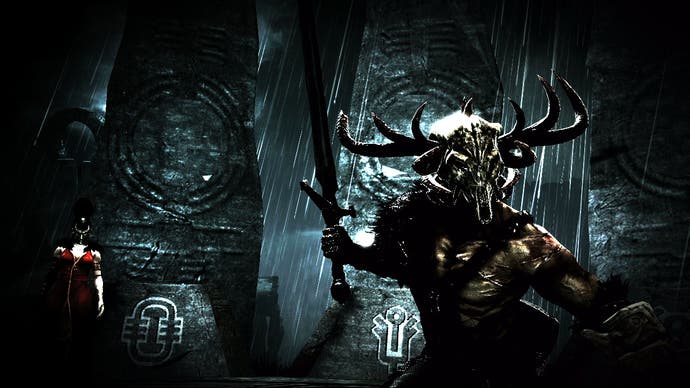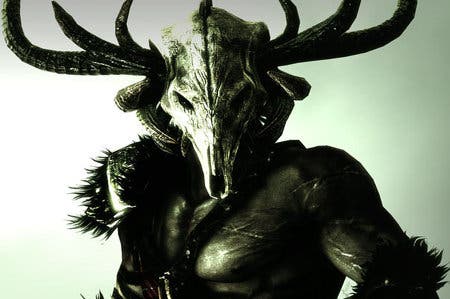Bloodforge Review
Bloody hell.
There's almost something refreshing about the way Bloodforge proudly wears its lack of originality or ambition on its sleeve. Essentially an off-brand God of War, with Greek myth replaced by Celtic, it barely sets a toe outside of genre boundaries that have been in place for years.
So you are, inevitably, a furious bundle of muscle and resentment, carving your way through waves of disposable foes. Your name is Crom (the actual Celtic legend that inspired Conan's deity) and you've been tricked by the gods into killing your own wife. This is a tragedy, though as the game doesn't show you Crom's face, preferring to keep him glowering behind a deer skull mask, any emotional investment will have to be supplied by the player, unaided.
So you plough through wave after wave of identical enemies in order to reach gigantic boss encounters, in which you dodge such familiar hazards as giant fists that pound the earth and eyes that blaze fire. Patience is rewarded with carelessly revealed openings which you can then exploit to inflict grisly damage, stabbing them repeatedly in the soft squishy bits with a spot of entry-level quick-time button matching.

In normal combat you mash the X button to unleash fast attacks, while Y handles your slower, heavier swings and triggers grisly execution moves on stunned enemies. You can also combine them to form rudimentary combos, using a variety of weapons - sword, sledgehammer or bone claws. Each enemy downed contributes to filling a gauge that can be unleashed to send your character into a berserker rage. There are magic attacks that can be upgraded by cashing in your points at special altars along your linear route.
It's a veritable buffet of old ideas, but that's not a bad thing in itself. Originality is always welcome, but that doesn't mean that a game which follows the pack is inherently bad. Uninspiring, yes, but even the choosiest gaming gourmand can glean fun from something without being inspired.
No, what sinks Bloodforge, and makes it the first real disappointment of an Xbox Live Arcade season that has already served up some of the best games of the year, is how these weary old gameplay elements have been implemented so half-heartedly. It's a sloppy game. A sloppy, glitchy, frustrating game, and it's all due to basic technical failings that should have been hammered out long before the game saw release.

The camera is by far the worst offender; a twitching, lurching thing that makes seasickness a more troublesome foe than any of the hulking grunts trying to cut you down. The camera's jerky movement is almost impossible to get used to, and it kills whatever grace and flow the crude combat system has to offer, wrenching your viewpoint from side to side and throwing your accuracy out of the window as it goes.
The game's 300-inspired desaturated look makes for some compelling screenshots, but it conspires with the camera to bludgeon whatever life is left in the twitching corpse of Bloodforge's melee combat. Characters blend into a monochrome splurge during fights and it's often impossible to tell where Crom is, let alone which enemy he's targeting or who is targeting him. There's no block, so your only defence is a sticky, erratic roll that leads you into harm's way as often as it gets you out of it.
This blunt approach renders the combo system surplus to requirements, as hammering X gets you through pretty much everything. Each weapon has a list of moves, but you rarely need them and often can't even see if you've pulled them off correctly. Even the weapons themselves fail to shake the game out of its one-note snooze. The hammer is heavier, the claws slightly faster than the sword, but Crom wields them all with the same lumbering swings so the only incentive to switch is because you've grown tired of watching the same execution animations over and over.

Even more ridiculous, Crom comes equipped with a crossbow that can be used to whittle away at enemies without ever coming into melee range. Yes, this is a melee combat game where you're better off staying out of fights and picking enemies off at a distance. It's hard to tell if this is a genuine exploit or a way of coping with the game's erratic difficulty. No single fight is particularly hard, but it's almost impossible not to keep taking damage in the muddled scrums and health refills are sparse. Checkpoints are poorly placed and restart you with the same health as when you first triggered them. It's entirely possible to find yourself trapped in an impossible situation, facing a big fight with a sliver of health, and the only out is to quit and play the whole level again.
Bloodforge doesn't even have anything else to offer beyond lumpen brawling. This is game shackled in repetitive corridors, with the occasional cul-de-sac for a power-up. There's no real exploration, no puzzles or anything that might force your brain to switch gears. If the fighting had an ounce of Bayonetta's grace or God of War's energy then this wouldn't be a problem, but it doesn't, and it is.
One of the few glimmers of fresh thinking comes from an integrated leaderboard system which tracks your performance in each level against that of your friends. The one who spills the most blood takes the top spot, but this is the sort of social idea that demands a large audience, not only of people playing the game but replaying its turgid levels to improve their ranking, and Bloodforge seems unlikely to attract that sort of devotion.
Bloodforge is the worst kind of disappointment. It looks good. It's following in the well-trodden footprints of a dozen better games. There's no excuse to the get the basics this wrong and there's no reason why slicing your way through a wall of enemies shouldn't be fun. Yet there's nothing that's fun here, only a monotonous bloody grind that copies everything from its peers except their polish.

